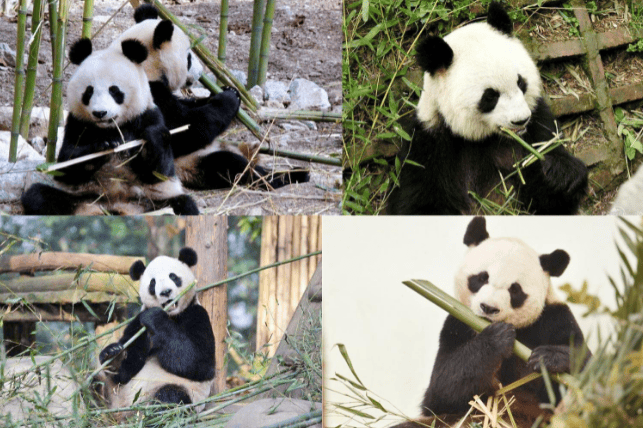In everyone’s impression, giant pandas are round, cute and cute animals. It is perfectly fine to think this way when you see them at the giant panda base or zoo, but what if you are in a giant panda reserve in the wild? See, be careful, because giant pandas have records of hunting goats and peacocks.

How could the giant panda, a ferocious beast, end up eating bamboo?
The giant panda is the only species in the genus Giant Panda of the Ursidae subfamily Giant Panda. It lived on the land of China 8 million years ago. To be precise, it can be regarded as a "living fossil". Of course, 8 million years ago The panda is not called a giant panda, but a primitive panda. At that time, it did not eat bamboo, but ate meat, and its body size was relatively large.
Lufeng Shi Panda
But in the early stages of the update, a panda smaller than the Shi Panda began to appear. It can be inferred from the teeth that it has begun to switch from a pure carnivorous diet. It is an omnivorous animal with well-developed molars. Bamboo shoots and bamboo occasionally begin to become its food. This transformation laid the foundation for its future survival in harsh natural environments.
Due to the ice age that followed, a large area of the northern hemisphere was covered by glaciers and food was scarce. The originally widespread pandas became extinct on a large scale. However, this kind of bear that can live on bamboo is obviously more vulnerable than other species. Having a competitive advantage, they have been able to survive in several areas. The panda's "hands" have also evolved into "thumbs" that are easier to grasp bamboo poles. However, they still cannot digest cellulose, only hemicellulose and starch in bamboo.
Because although bamboo shoots are rich in nutrients, they have too much fiber and limited energy supply, and there is only a short time in the year. The breeding period of giant pandas is during the season when bamboo shoots occur. Except for this time, other times They can only eat bamboo, but the energy provided by bamboo is even lower. In addition to eating bamboo and sleeping, giant pandas spend 2/3 of their time eating. Fortunately, the chubby giant panda does not exercise much and consumes relatively low energy.
This has also seriously restricted the development of the giant panda population. This species is either eating or sleeping all day long, and there is no time to expand breeding grounds. By the time of statistics in 1985, there were only 1,114 in the wild. Moreover, the giant panda has a low litter rate and a high cub mortality rate, causing this species to wither away.
Before the giant panda has sex, he actually wants to watch a short movie!
Giant pandas who eat, sleep, and eat every day live like this every day. It’s no wonder that during the breeding season, they have to look for the season when bamboo shoots are growing. After all, only when they eat nutritious food can they have the strength to do other things. Well, the season when bamboo shoots appear becomes the breeding season for giant pandas.

The New York Times Chinese website published a very interesting article online on October 8, 2016, titled "Why are giant pandas all frigid?" "", and the content is even more shocking. In order to allow giant pandas to breed smoothly, they have to watch short movies for giant pandas! what is happening? The giant panda has actually reached this point?
One of the big reasons is that the menstrual cycle of giant pandas is very short. Male and female giant pandas only have estrus once a year in spring, and the duration is very short, and the pregnancy period is only 24 to 72 hours. , that is to say, if the male giant panda is not around at this time, or there is no "demand" for the female giant panda, or poor technology leads to failure to get pregnant, then I'm sorry, let's wait until next year.
Do you think the male is not ready? Not at all. The breeding period of giant pandas is from March 22nd to April 15th every year. During this period, the testicles of male giant pandas increase, and the amount of semen discharged is several times that of the non-breeding period. But once the breeding period is over, , the pandas save energy to recuperate.
It seems that the two parties are working together perfectly, why do they have to go to the level of watching a short movie?
It’s very simple. Giant pandas are solitary animals. Neither party has “experience” and the possibility of mutual cooperation is very low. Moreover, a more serious problem is that there is no “freedom” between giant pandas in nature. "Love", although this will lead to a lower probability of natural mating, in captivity, the two parties are "matching each other", and the male and female giant pandas stare at each other with big eyes and small eyes, but they don't know what to do!
Of course, a more important reason is that captive giant pandas have less activity, are well fed all day long, pampered, and have no pressure to survive. According to domestic and foreign statistics, at least 60% of male giant pandas are in estrus. There is no need for mating, and only 10% of the remaining 40% have successful natural conceptions, because male pandas need strong hind limbs to support their huge weight when mating, and the strength of captive pandas is not small. Artificial breeding of giant pandas is accomplished through artificial insemination.
But this is obviously contrary to the giant panda’s wild training plan and future survival. In order to solve this problem, panda experts at the China Giant Panda Breeding and Conservation Center in Wolong, Sichuan, in addition to increasing the panda’s activity, also They came up with an excellent idea, which is to play "sex education films" to the pandas, which are documentaries of male and female giant pandas mating with successful natural conception, to stimulate their desire to mate.
This method is indeed quite effective. Since this method was implemented in 1998, the natural conception rate of giant pandas at the China Giant Panda Breeding and Conservation Center in Wolong, Sichuan has increased significantly. Of course, more of them are through artificial insemination. Completed, it still cannot completely solve the problem.
However, fortunately, the environment of the giant panda wild protection base has improved, and the number of giant pandas has increased, which has alleviated the anxiety of experts. At least from this point of view, giant pandas are no longer worried about extinction in the wild. , but we should not take it lightly. After all, giant pandas are busy looking for food or sleeping all day long. The natural fertilization period is so short, and males are very Buddhist. In a word, it is too early to say that the danger to giant pandas is completely eliminated.

 扫一扫微信交流
扫一扫微信交流
发布评论